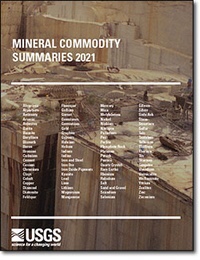 2020 may go down in history as the year in which our world changed drastically, but one thing remained largely steady, according to the latest USGS Mineral Commodity Summaries, one of our favorite reports which is hot off the press: Our nation’s mineral resource dependencies. However, as followers of ARPN will know, that is hardly a good thing, as our degree of import reliance for critical minerals in recent years has consistently been too high for comfort.
2020 may go down in history as the year in which our world changed drastically, but one thing remained largely steady, according to the latest USGS Mineral Commodity Summaries, one of our favorite reports which is hot off the press: Our nation’s mineral resource dependencies. However, as followers of ARPN will know, that is hardly a good thing, as our degree of import reliance for critical minerals in recent years has consistently been too high for comfort.
A look at the chart depicting U.S. Net Import Reliance — or the “Blue Wall of Dependency,” as we have dubbed it based o the many blue bars showing 100% import dependence, reveals that we are still 100% import dependent for 17 of the metals and minerals included in the USGS report, unchanged from the previous year. However, the number marks a stark contrast to our import reliance for metals and minerals in 1984, when we were 100% import reliant for just 11 commodities.
The number of metals and minerals for which we are 50% or more than 50% import dependent is unchanged over last year — the report pegs it at 47.
Of note, while we had seen a drop in dependency for foreign supply of lithium (down to >25%) last year, that number has gone up again to >50%. This is particularly relevant as lithium is one of the key components of green energy technology, the importance of which is only set to grow under the new Biden Administration.
China continues to be the elephant in the data room, and is listed 24 times as one of the major import sources of metals and minerals for which our net import reliance is 50% or greater. That is down by one, however that change is owed only to the fact that garnet has slightly dropped in import reliance (to 48%, and not to a diversification of sources away from China.
This may change going forward, as 2020 has underscored the urgency of strengthening our domestic supply chains, and has yielded some important progress with regards to policies aimed at reducing our over-reliance on foreign, and especially Chinese metals and minerals. Executive Order 13953 declaring a critical minerals national security emergency, several key provisions of which were later codified in the Energy Act of 2020, as well as parts of the National Defense Authorization Act come to mind here.
However, meaningful change takes time, and whether we will see significant changes in the numbers on our favorite chart going forward, will depend largely on the extent to which stakeholders will act on these provisions and implement policies that bring us closer to an all-of-the-above approach on critical minerals.
Click here to read this year’s Mineral Commodity Summaries.
For previous iterations, click here.




